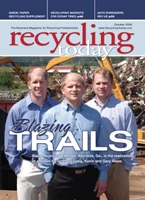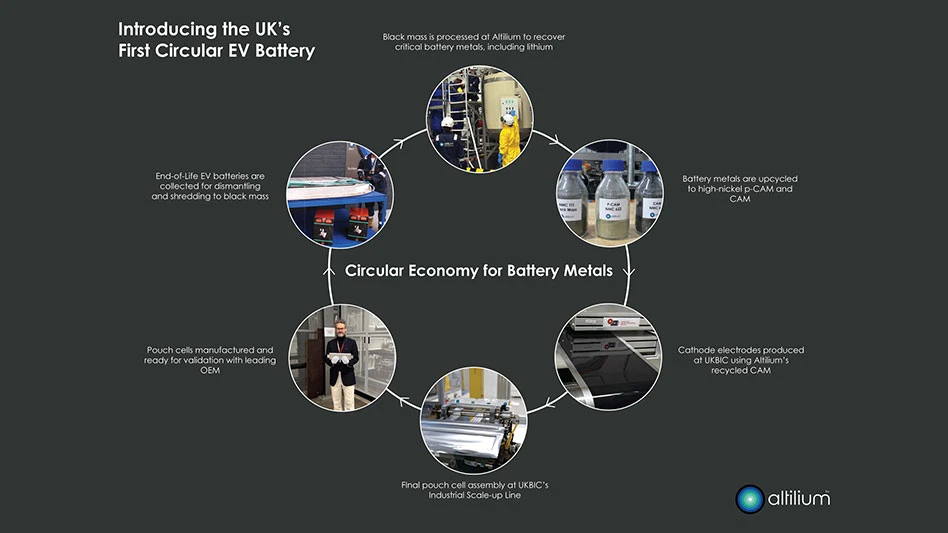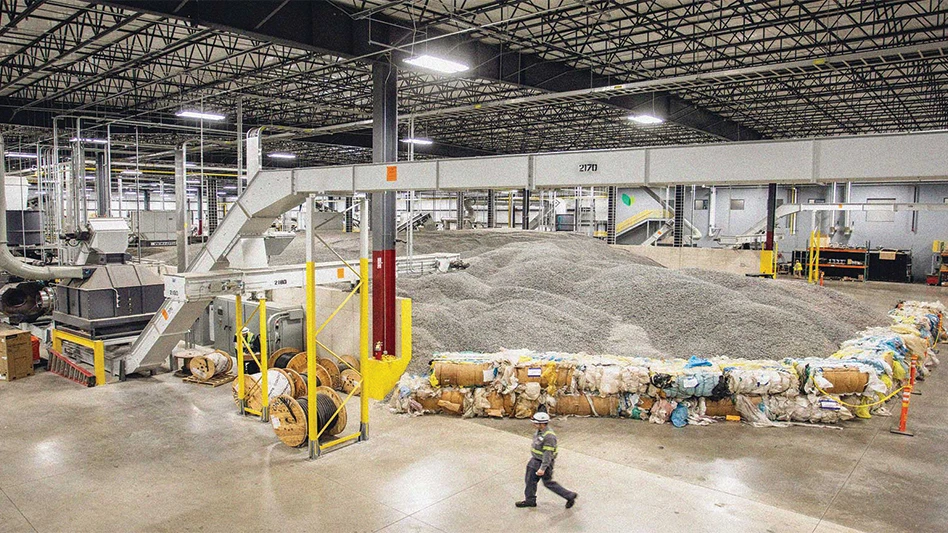| Editor's Note |
|
This article is an edited version of a presentation given by David Forresterat the Institute of Scrap Recycling Industries Inc. Tire Recycling Business Summit in Rosemont, Ill., in September 2006. |
I have been asked to talk about the overall state of the industry and am thrilled to do that in a year of unprecedented sales. My focus will be on where we are and, more importantly, on what it takes to keep the "good times rolling."
For many of you in the business today who have been involved in the industry since 1999 or before, this could be your best year ever. Overall, things seem to be going gangbusters in our world, so it is an important time to stop and consider what all this growth means and how we sustain it.
To understand where we are and what we need to work on, I will look at our current markets by product type as well as at the trends in pricing in each of those product categories. I will also look at the evolution of the industry as a whole and what is going on in our customer base.
We will then look at the issues, or opportunities, if you prefer, that face us at a global level, an industry level and then those issues that each of us needs to address. Finally I will offer my thoughts on how each of us, by adding value, can contribute to the industry’s and our own continued success.
THE TRIFECTA. 2006 really is the year that we as an industry have hit the trifecta. We have growth in all our markets and in some cases spectacular growth. We have prices for our products rising at unprecedented rates and we have new markets developing that could lead to even greater growth and success in the future.
Looking at the seven main categories of products that we sell, we see that:
1) We have the used tire market, which is experiencing double-digit growth, as pretty much everyone in the scrap tire world is now engaged in culling and selling used tires. As the less developed countries grow their economies and get more automobiles, they have high levels of demand for tires that are considered borderline in this country. And even in this country, now as people are becoming more concerned about economics, the market for used tires is strong.
2) The stampings market is limited by the ongoing decline in the number of bias-ply tires, but in spite of this is experiencing continued growth.
3) The use of whole tires for fuel is growing as more cement kilns make the changeover to tires as fuel. Beyond kilns the market seems limited as there are large technological hurdles to success in the whole-tire-for-energy world.
4) Tire-derived fuel is literally on fire. Demand is growing in direct correlation to the increases in energy costs. If only 25 percent of the industries looking at using TDF do so, we will see triple-digit growth in the next few years. There are, of course, some barriers, including a major one involving environmental permitting.
5) Large crumb, which I define as larger than ¼ inch, is enjoying sales growth in the 50-percent-plus range primarily because of the significant growth in mulch markets.
6) Mid-size crumb, which I describe as minus-¼ and plus-20 mesh, is also growing at better than 50 percent primarily because of the infill market, but also because of sustained growth in the industrial markets (mostly compression molding).
7) And the markets for fines (minus-20 mesh) and super fines (minus-60 mesh) are continuing to grow at steady rates and have the potential to join the other crumb markets with 50 percent type growth rates if the reliability of super fines production gets the tire industry more engaged and if polymer-modified asphalt continues to demonstrate success.
This is all great news, of course, but it is scary that three of these markets (TDF, mulch and infill) are coming up substantially short of desired volumes (e.g. approximately 100 artificial turf field jobs will be moved into next year at least partially for lack of rubber).
INCOME STRIDES. The news is even better on the pricing side. After a decade of fairly flat pricing in most markets, we have double- to triple-digit pricing increases in five out of seven markets.
1) Used tires are selling at double or more of their pricing from five years ago.
2) Stampings are seeing price increases better than inflation.
3) Whole tire fuel is seeing the equivalent of 100 percent price improvements as kilns are accepting lower and lower tipping fees.
4) TDF prices of more than $50 per ton are now relatively normal, whereas only two or three years ago pricing in the low $20s was the norm.
5) Mulch has driven pricing of ½- to 1-inch chips up to double or triple what the same chip was selling for as feedstock a year or two ago.
| Cabable of Better |
|
I believe we are capable of excellence, and any ongoing poor treatment of customers and vendors is not in our best interest. We need to be our own worst critics because there is so much perception out there that we are a "trashy" industry. Only through concerted demonstration of something other than that perception will we start to develop a new and improved impression of professionalism. It is not my intent to suggest that we as an industry are awful. In fact, as an industry veteran of 15 years, I am thrilled at the improvements I see. But I am also deeply concerned about our ability to sustain our current successes and to further grow and advance the industry. I would like to offer some thoughts on how we make the next few years even more successful than this year. No one in our industry wins when we find ourselves with extra capacity and end up "dumping" it in someone else’s market for less. Our focus needs to be on building new markets or growing existing markets, not simply stealing share from a competitor through depressed and unrealistic pricing. Work on better safety, work with others on best practices (success comes from continuous improvement). We need more common standards and specifications and we need more lobbying on workforce and insurance issues. I believe we as an industry have a technology problem and we are letting our vendors "get away with it." We need to work with our vendors to develop, improve and design equipment that works and runs with high reliability and performance. --David Forrester |
6) After years of no price increases, 10-mesh has seen a 10-15 percent increase per year for two or three years running and is probably looking at another year of that type of increase in 2007.
7) The fines market is finally recovering from some of the crazy discounting of the last few years and is returning to pre-2004 price levels.
For years we have heard that if only the tire recycling industry was more reliable there would be more people willing to buy more product. We are seeing the proof of this now as the strengthening of our industry and the better players with better performance are helping generate more interest and more sales. This improvement in industry performance also helps create new interest as people see a raw material supply at reasonable prices that can be obtained on a predictable and repeatable basis.
Our customer base is further expanded by the direct and indirect affects of energy prices. Not only is TDF more attractive, but when competing with raw materials that are either petroleum-based or imported from great distances, recycled rubber looks more attractive.
And finally we are seeing the impact of more interest in environmental causes as both the public (mulch and playground materials) and industry seek higher-value answers to the scrap tire issue.
STILL SOME ISSUES. So things are great and the future looks bright, but what are the issues we need to be concerned about and working on?
In a broad or global sense we have some major challenges. For those of us in the tire collection side of the scrap tire markets, the fuel price increases of the last two years have been extremely painful, as few in our industry had fuel surcharges built into our contracts (but we do now). The volatility of the oil-producing world makes transportation costs an X factor for all of us moving forward.
Tire composition is changing. Many of us in the crumb business found a new plastic-like fiber in our crumb. This material, depending on your processing technology, could create major problems for you in certain markets, particularly the playground or infill markets where the sharpness of these plastic-like fibers could be a hazard.
Our workforce issues are only getting worse. The most readily available workforce, immigrant Hispanics, is suddenly becoming unavailable because of immigration issues. The current furor over illegal immigration as well as the sustained low level of unemployment are making the task of staffing our operations harder than at any time in recent history.
Finally, we find ourselves in the initial stages of what many argue will be the total globalization of the world’s economy. Who among us can be sure that the customers we currently ship our products to will not disappear as lower cost or alternative materials replace our products?
Bottom line: We live in an ever-changing world that we cannot predict or control.
As if that isn’t enough, we have challenges within our industry. Five years ago rubber mulch and artificial turf infill were relatively small markets. What if the pallets and pallets of mulch on the shelves at Home Depot and Lowe’s start sitting there and the retail world gives up on it? What if the turf world once again, as it did in the 1980s, decides that natural grass is the best and artificial turf sales dive? These are real possibilities, and if these marketplace changes do not take place, others will.
Who in the room remembers Landstar? They were just one of a series of companies in the last 10 years that were going to roll up the industry…and of course there are some players today with similar aspirations. What does industry consolidation do to the prospects of individual processors? What does it portend for the industry? Great questions. Sorry, no answers, but I feel confident that it will be an interesting ride.
And what about the world of government regulations as they relate to our industry? Currently there is a legal challenge in United States District Court wherein environmentalists are challenging under what rules the use of TDF is managed. If the environmentalists win, it would mean that the use of TDF would be treated as waste incineration with a much tougher set of standards for permitting and emissions. This could have a dramatic impact on current and possible future TDF consumption. Additionally, as the scrap tire problem diminishes there will be pressure on state legislatures to drop their state mandated fees and programs, without which the industry may find itself re-experiencing the problems of the late 1980s with tire piles and fly-by-night operations.
Sponsored Content
Labor that Works
With 25 years of experience, Leadpoint delivers cost-effective workforce solutions tailored to your needs. We handle the recruiting, hiring, training, and onboarding to deliver stable, productive, and safety-focused teams. Our commitment to safety and quality ensures peace of mind with a reliable workforce that helps you achieve your goals.
Sponsored Content
Labor that Works
With 25 years of experience, Leadpoint delivers cost-effective workforce solutions tailored to your needs. We handle the recruiting, hiring, training, and onboarding to deliver stable, productive, and safety-focused teams. Our commitment to safety and quality ensures peace of mind with a reliable workforce that helps you achieve your goals.
While these issues may be beyond our individual efforts, they are not beyond the efforts of industry groups such as ISRI, and I strongly encourage you to become well versed in the issues and express your point of view clearly and often.
IMPROVING THE INDUSTRY. The preceding topics dealt with issues in the larger world outside of our day-to-day operations. But there are several key issues for us in our day-to-day world:
Are zero tip fees in our future? Probably, but not real soon except in certain arenas. Strong demand for all black and TDF could drive tipping fees down close to zero in certain regions.
The control and availability of raw materials could become one of our primary issues near term.
How many of you remember the famous ISTEA (Intermodal Surface Transportation Efficiency Act) legislation of the early 1990s? This is the bill that mandated the use of crumb rubber in federally funded asphalt projects. The result was an incredible surge in investment and capacity in the crumb rubber world: close to 100 new companies in a two-to-three-year period. In the period from1991 to 1996, crumb prices dropped 20 percent and did not fully recover until the last two to three years.
Well we are now looking at market conditions that could stimulate a similar growth in capacity, which in turn could generate the age old phenomenon of "buying sales." Once that process starts and margins start to disappear, people go into survival mode and start cutting corners to keep their doors open. The net result: The industry returns to the "bad old days."
I am not saying this is inevitable, but just a very possible scenario given current strong markets.
Supply and pricing issues are real, but what really scares me most is our industry’s continuing issues and shortfalls in the areas that directly affect our customers and our image.
We are stronger today as an industry because we have started to change these perceptions, but we still fail to treat customer requirements with the urgency they deserve.
While I do not suggest that these flaws will doom the industry I am certain they will, unimproved, hurt our effort to grow and especially hurt efforts to move up the value hierarchy.
How many of you have made a delivery commitment to a customer this year that you have not met? Did the customer find out by an advance warning from you or by their delivery not showing up when expected? We are still storytellers when we need to be dependable.
PROFESSIONALISM. Our industry is where it is today because of a growing and paying customer base. We must show our customers daily that we care as much about their business as [we do about] ours and, as part of this and to grow industry integrity, we must value our commitments.
We are a maturing industry but one that is still going to see many shifts and changes. The safest course to survival is to cover the broadest range of products and services you can without diluting your performance and your focus.
We must stay active in market development and vigilant about market and landscape changes. As in all aspects of life, the most adaptable survives.
We are sitting on the strongest markets in our young industry’s history. We have healthier companies and a more organized and impactful industry. We have learned and gotten better.
Now, as we look ahead, we can see many challenges but none that we are not up to. So go out and do good. Add value and let the good times roll.
The author is president and CEO of Global Tire Recycling Inc., Wildwood, Fla., and TIRES Inc., Winston-Salem, N.C., and can be contacted vie e-mail at DavidForr@aol.com.
Get curated news on YOUR industry.
Enter your email to receive our newsletters.

Explore the October 2006 Issue
Check out more from this issue and find your next story to read.
Latest from Recycling Today
- Returpack reports increased DRS activity in Sweden
- Trade groups align against European export restrictions
- Construction, auto sectors show mixed signals
- Politics in Turkey threaten recycled steel outlet
- Toppoint Holdings expands chassis fleet
- Lego creates miniature tire recycling market
- Lux Research webinar examines chemical recycling timetables
- Plastics producer tracks pulse of wire recycling market







